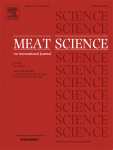Ver ítem
- xmlui.general.dspace_homeCentros e Institutos de InvestigaciónCIA. Centro de Investigaciones de AgroindustriaInstituto de Tecnología de AlimentosArtículos científicosxmlui.ArtifactBrowser.ItemViewer.trail
- Inicio
- Centros e Institutos de Investigación
- CIA. Centro de Investigaciones de Agroindustria
- Instituto de Tecnología de Alimentos
- Artículos científicos
- Ver ítem
Oxidative stability and its relationship with natural antioxidants during refrigerated retail display of beef produced in Argentina
Resumen
The objective of this study was to determine if pasture or grain diets affect oxidative/antioxidative status and the color stability of beef during retail display. Ten crossbreed steers were fed on pasture. Five of them were randomly assigned to remain on this diet, and the other five were finished on feedlot system (grain diet) during 110 days until slaughter. Slices of Psoas major steaks were randomly distributed among retail display times (1, 3, 5, 7
[ver mas...]
The objective of this study was to determine if pasture or grain diets affect oxidative/antioxidative status and the color stability of beef during retail display. Ten crossbreed steers were fed on pasture. Five of them were randomly assigned to remain on this diet, and the other five were finished on feedlot system (grain diet) during 110 days until slaughter. Slices of Psoas major steaks were randomly distributed among retail display times (1, 3, 5, 7 and 9 days). Lipid and protein oxidation were higher in Psoas major steaks from grain diet than in pasture diet (P < 0.05). After 3 days of display, lipid oxidation increased in meat from grain diet, whereas in meat from pasture diet the first evidence was after 7 days (P < 0.05). Protein oxidation was higher in meat from grain diet than in meat from pasture diet at day 9 of display (1.15 ± 0.92 vs. 1.91 ± 0.70 μg/g, respectively; P < 0.05). Antioxidant vitamins, α-tocopherol and β-carotene were higher at time = 0 in pasture Psoas major steaks (P < 0.05) and were differentially reduced throughout storage. While α-tocopherol decreased 41% and 57% for pasture and grain beef respectively (P < 0.05), β-carotene levels remained practically unaffected in grain beef. After 7 days of display “a” value was higher for Psoas major steaks from pasture diet (P < 0.05). Besides, “L” parameter showed higher values for samples from grain diets but it was no affected by display time. No differences were observed between both treatments for “b” value, but a significant decrease (P < 0.05) was observed along storage.
Superoxide dismutase and catalase activity was stable throughout storage, while glutathione peroxidase activity decreased significantly (P < 0.05). The results in this study demonstrated that the higher initial level and synergistic action (under light and air) of α-tocopherol and β-carotene found in pasture-finished animals improved the oxidative and color stability of beef, as showed by a better retention of redness at the end of retail display.
[Cerrar]

Fuente
Meat Science 79 (3) : 444-452 (July 2008)
Fecha
2007-10-24
Editorial
Elsevier
ISSN
0309-1740
Formato
pdf
Tipo de documento
artículo
Palabras Claves
Derechos de acceso
Restringido
 Excepto donde se diga explicitamente, este item se publica bajo la siguiente descripción: Creative Commons Attribution-NonCommercial-ShareAlike 2.5 Unported (CC BY-NC-SA 2.5)
Excepto donde se diga explicitamente, este item se publica bajo la siguiente descripción: Creative Commons Attribution-NonCommercial-ShareAlike 2.5 Unported (CC BY-NC-SA 2.5)

